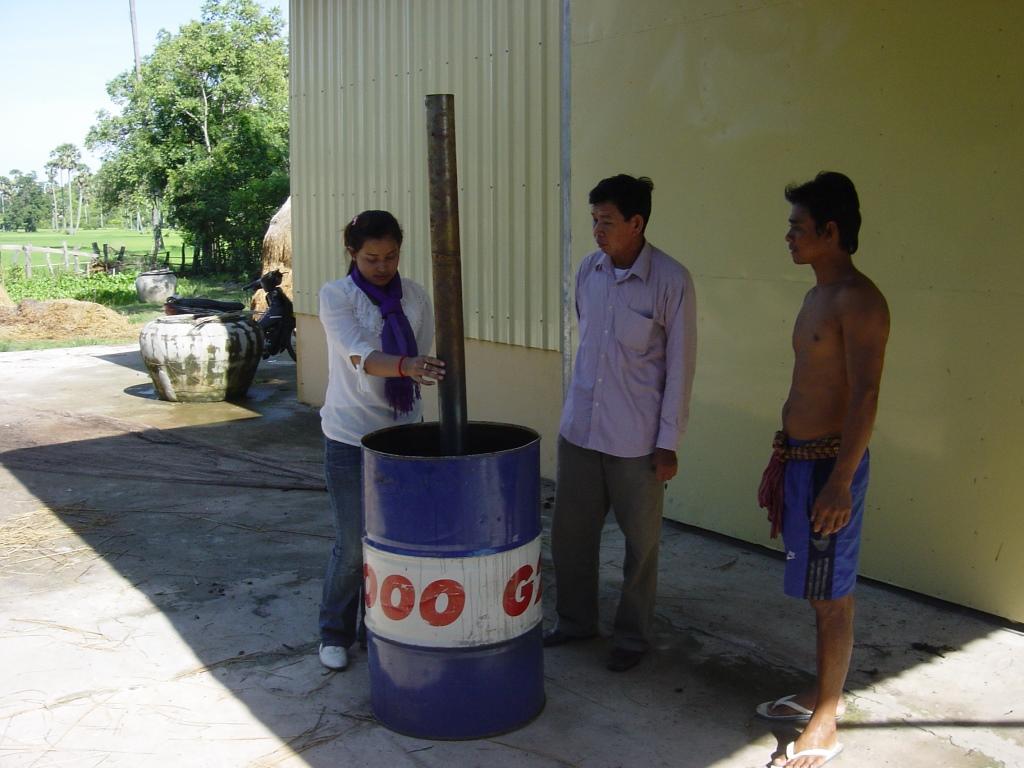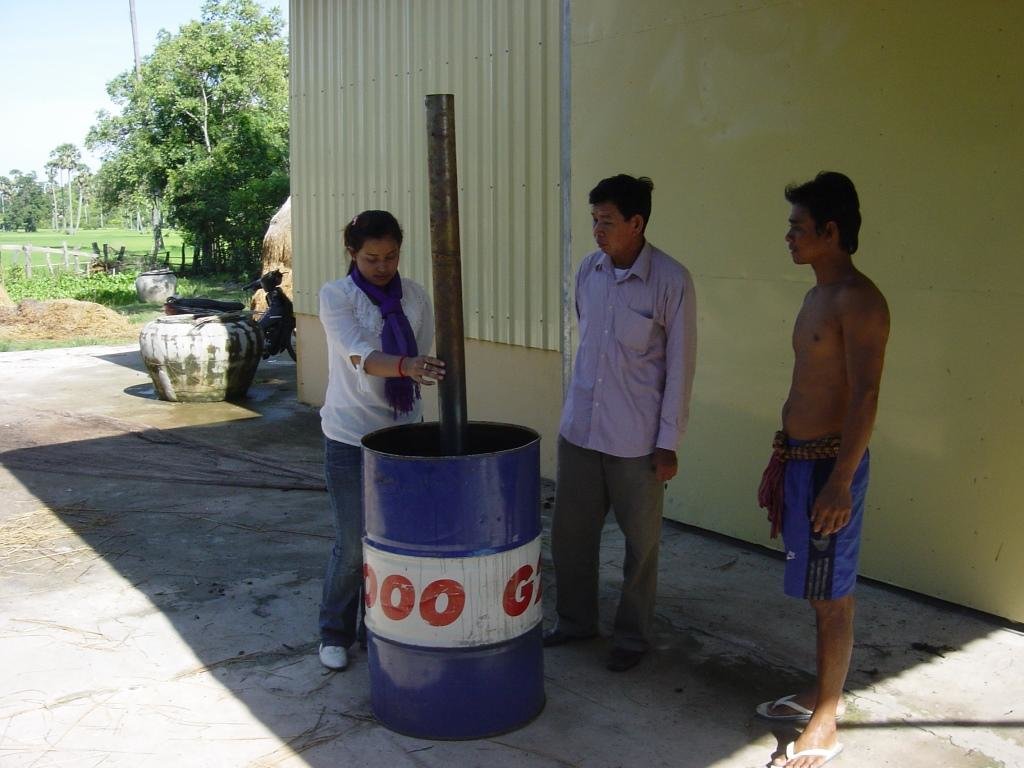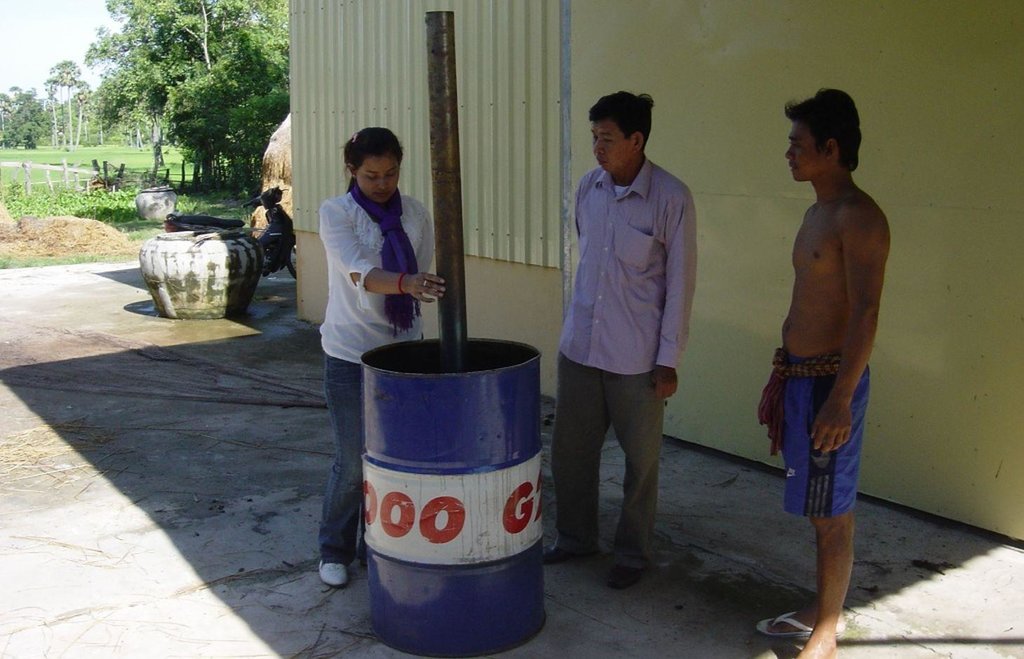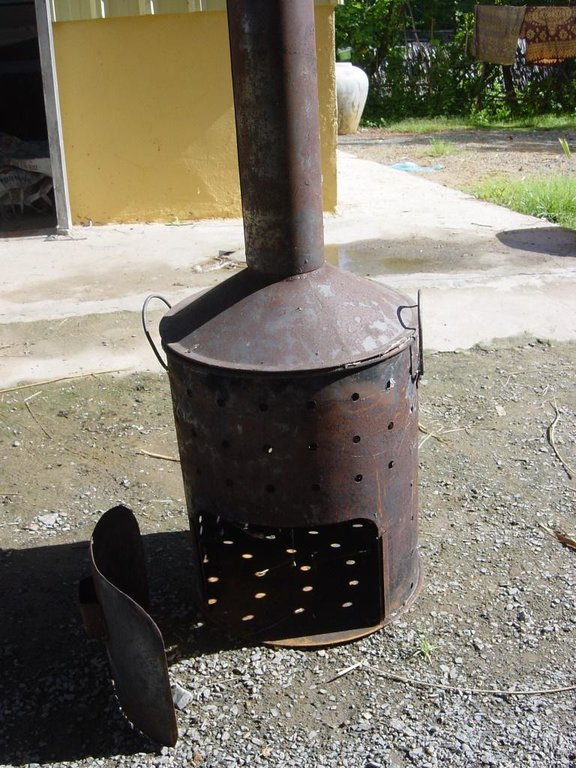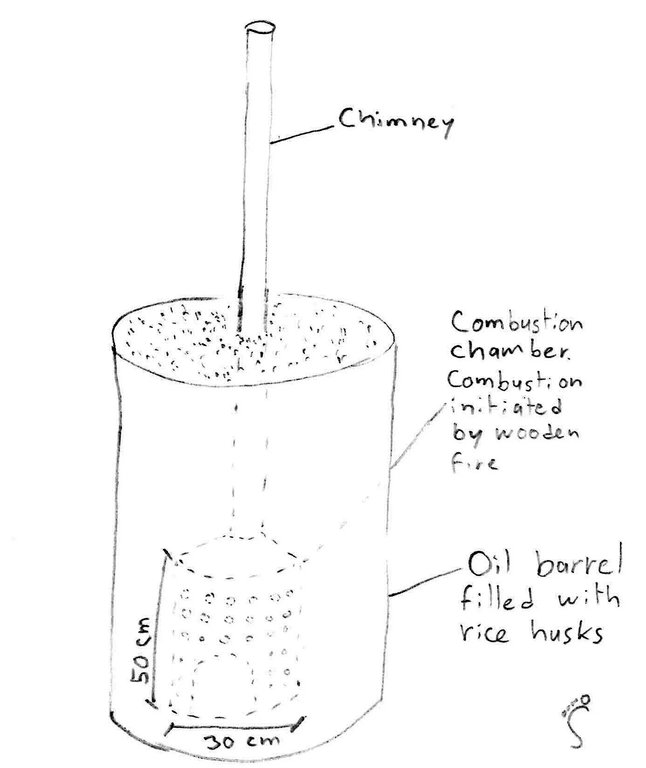Production and use of rice husk biochar in rice seed beds and vegetable production. [Cambodia]
- Creación:
- Actualización:
- Compilador: Stefan Graf
- Editor: –
- Revisores: Alexandra Gavilano, Deborah Niggli
ការផលិត នឹងប្រើប្រាស់ជីធ្យូងអង្កាមលើថ្នាលសំណាបនឹងដំណំាបន្លែ (Khmer)
technologies_1229 - Cambodia
Visualizar secciones
Expandir todo Colapsar todos1. Información general
1.2 Detalles de contacto de las personas de referencia e instituciones involucradas en la evaluación y la documentación de la Tecnología
Especialista MST:
Khun Lean Hak
kleanghak@yahoo.com / sofdec@camintel.com
SOFDEC/LAREC, www.sofdec.org
Cambodia
Especialista MST:
Pith Khonhel
khonhel@gmail.com
LAREC
Cambodia
Especialista MST:
Bin Sreytouch
Sreytouchbin@gmail.com
SOFDEC
Nombre de la(s) institución(es) que facilitaron la documentación/ evaluación de la Tecnología (si fuera relevante)
Society for Community Development in Cambodia (SOFDEC) - CambodiaNombre de la(s) institución(es) que facilitaron la documentación/ evaluación de la Tecnología (si fuera relevante)
Local Agricultural Research and Extension Centre (LAREC) - Cambodia1.3 Condiciones referidas al uso de datos documentados mediante WOCAT
¿Cuándo se compilaron los datos (en el campo)?
14/08/2014
El compilador y la/s persona(s) de referencia claves aceptan las condiciones acerca del uso de los datos documentados mediante WOCAT:
Sí
1.4 Declaración de la sostenibilidad de la Tecnología descrita
¿La Tecnología aquí descrita resulta problemática en relación a la degradación de la tierra, de tal forma que no puede considerársela una tecnología sostenible para el manejo de la tierra?
No
2. Descripción de la Tecnología MST
2.1 Breve descripción de la Tecnología
Definición de la Tecnología:
Rice husks as well as empty seeds are pyrolised and used as a soil amendment in the rice seed beds and the vegetable gardens.
2.2 Descripción detallada de la Tecnología
Descripción:
Biochar is the residue left after the pyrolysis of any organic matter and is used as a soil amendment. Pyrolysis occurs when the organic matter is heated in anaerobic conditions, which is usually done in specially designed kilns. Sometimes it is also made in a conventional fire, which is extinguished before the char turns to ash. Agricultural wastes like rice husks or unfilled grains are mainly used. Biochar can have many positive effects on the soil and plants:
-It buffers the pH, and has usually a high pH due to theash content.
-Due to its porous structure, it holds water and serves as refuge for microorganisms.
-It absorbs and adsorbs nutrients, both cations and anions. They are available for the plant roots.
-It can increase the resistance of plants to diseases.
Due to all these effects, the increased yields are higher than those that can be achieved only through the nutrients contained in the Biochar itself. Biochar is and was used in many parts of the world as soil amendment, with some benefits persisting for centuries. In Cambodia it was used during the Pol Pot regime to reduce the smell of the human faeces that were used on the fields due to a lack of other fertilizers. Today research in the Biochar domain is increasing, especially since the discovery of the man-made terra preta soils in South America.
Biochar is mainly used to increase the fertility, water holding capacity and carbon content of the soil. The fact that the benefits of Biochar addition to the soil remain for several years, unlike chemical fertilizers, makes it attractive to farmers. Other purposes, like the increased resistance of plants to diseases and buffering of nutrients are also of importance.
Biochar was introduced or reintroduced trough different NGOs, JICA (Japanese International Cooperation Agency) in this case study. Because of knowledge exchange between farmers, a rice husk char/ash mix, as residue from the pottery baking, was used already in 2011. In 2013 JICA borrowed a Biochar kiln to the local farmer self-help group with a training, so they could produce Biochar by themselves. The inner part of the kiln (cf. technical drawing) is filled with wood and lit. It is then put into an empty oil barrel, which is filled with rice husks. The heat pyrolyses the husks from the bottom to the top of the barrel, and the gases are burned in the inner part of the kiln and the chimney. Just before the upper part is pyrolysed, the husks are extinguished. There is a weight loss of about 50 to 60 % caused by this process. The Biochar is added to the fields after ploughing, and the fields are harrowed. In this case study, Biochar is used both in rice seed beds and in a vegetable patch. Concentrations of 0.5 kg/m2 are used in the rice seed bed, and 2.5 kg for the vegetables. Due to the little available quantities of husks, Biochar is not applied to the field yet. The use of Biochar is spreading quickly from farm to farm
The analysed area is flat (slope < 2%), with a tropical climate (dry season from November to May and wet season from June to October), and the soils are mostly sandy or loamy. The soil has a low fertility, contains little organic matter, and acidifies. The area has been deforested a long time ago, and the groundwater table is rather high (1-2 m during the dry season, on the surface during wet season).
Due to climate change, farmers notice more erratic rainfall, temperature rises and more recurrent droughts. Rice is the predominant crop grown in the area, since it serves as staple food (mix subsistence and commercial activities). Cattle are usually grazing on the fields after the harvest, without much control. Thus the cattle grazes too often and too much on the same spot, leading to degradation.
The increasing migration rate (the young generation leaves the villages to work in the cities, garment industry or abroad) results in a decrease of available labour force in the area which has detrimental effects on the agricultural activities. Furthermore, the civil war in the 1970s (Khmer Rouge) led to the loss of agricultural knowledge. Several NGOs are trying to re-establish the knowledge.
2.3 Fotografías de la Tecnología
2.5 País/ región/ lugares donde la Tecnología fue aplicada y que se hallan comprendidos por esta evaluación
País:
Cambodia
Región/ Estado/ Provincia:
Kampong Chhnang
Especifique más el lugar :
Kraing Leav
Map
×2.6 Fecha de la implementación
Si no se conoce el año preciso, indique la fecha aproximada:
- hace menos de 10 años (recientemente)
2.7 Introducción de la Tecnología
Especifique cómo se introdujo la Tecnología:
- mediante proyectos/ intervenciones externas
Comentarios (tipo de proyecto, etc.):
It was introduced in 2010 by JICA, the Japanese International Cooperation Agency.
3. Clasificación de la Tecnología MST
3.1 Propósito(s) principal(es) de la Tecnología MST
- mejorar la producción
3.2 Tipo(s) actuales de uso de la tierra donde se aplica la Tecnología

Tierras cultivadas
- Cosecha anual
Cosechas principales (comerciales y de subsistencia):
Livestock is grazing on crop residues
Comentarios:
Major land use problems (compiler’s opinion): Soil fertility decline, water availability
Major land use problems (land users’ perception): Water availability. Interestingly the farmer says that soil fertility is not a problem, as the farmers know about the use of compost. The compost application is the problem.
3.3 Información adicional sobre el uso de tierras
Provisión de agua para la tierra donde se aplica la Tecnología:
- mixta de secano – irrigada
Número de temporadas de cultivo por año:
- 1
Especifique:
Longest growing period in days: 210, Longest growing period from month to month: June-December
3.4 Grupo MST al que pertenece la Tecnología
- manejo integrado de la fertilidad del suelo
3.5 Difusión de la Tecnología
Especifique la difusión de la Tecnología:
- distribuida parejamente sobre un área
Si la tecnología se halla difundida homogéneamente en un área, indique el área aproximada que cubre:
- 0.1-1 km2
Comentarios:
Area unknown and rapidly spreading.
3.6 Medidas MST que componen la Tecnología

medidas agronómicas
- A2: materia orgánica/ fertilidad del suelo
3.7 Principales tipos de degradación de la tierra encarados con la Tecnología

deterioro químico del suelo
- Cn: reducción de la fertilidad y contenido reducido de la materia orgánica del suelo (no ocasionados por la erosión)
- Ca: acidificación

degradación del agua
- Ha: aridificación
Comentarios:
Main causes of degradation: soil management (Ploughing and bare soil during dry season.), labour availability (Farmers go to work in the garment industry, in construction, or sell their labor elsewhere.)
Secondary causes of degradation: deforestation / removal of natural vegetation (incl. forest fires) (Deforestation happened many years ago.), overgrazing (Uncontrolled grazing during dry season.), change in temperature (More hot days according to UNDP and farmers.)
3.8 Prevención, reducción o restauración de la degradación de la tierra
Especifique la meta de la Tecnología con relación a la degradación de la tierra:
- reducir la degradación de la tierra
4. Especificaciones técnicas, actividades de implementación, insumos y costos
4.1 Dibujo técnico de la Tecnología
4.2 Especificaciones técnicas/ explicaciones del dibujo técnico
Biochar kiln. In the inner part, the combustion chamber, a wooden fire is lit. The burning chamber is then placed in the oil barrel, which is filled with rice husks. The heat pyrolyses the husks, the gas burn in the chamber and chimney. When pyrolysis is almost completed, the char is extinguished.
Kampong Chhnang
Date: 2014
Technical knowledge required for field staff / advisors: high
Technical knowledge required for land users: moderate (When farmers only buy Biochar the required technical knowledge is low.)
Main technical functions: increase in organic matter, increase in nutrient availability (supply, recycling,…)
Secondary technical functions: improvement of surface structure (crusting, sealing), improvement of topsoil structure (compaction)
Manure / compost / residues
Material/ species: Rice husk Biochar (together with compost, which he already did before)
Quantity/ density: 0.5-2.5
Remarks: Entity: kg/m^2. Distributing on fields and harrowing.
4.3 Información general sobre el cálculo de insumos y costos
otra / moneda nacional (especifique):
Riels
Indique la tasa de cambio de USD a la moneda local (si fuese relevante): 1 USD =:
4000,0
Indique el costo promedio del salario de trabajo contratado por día:
5.00
4.4 Actividades de establecimiento
| Actividad | Tipo de medida | Momento | |
|---|---|---|---|
| 1. | biochar kiln |
4.5 Costos e insumos necesarios para el establecimiento
| Especifique insumo | Unidad | Cantidad | Costos por unidad | Costos totales por insumo | % de los costos cubiertos por los usuarios de las tierras | |
|---|---|---|---|---|---|---|
| Equipo | kiln | 1,0 | 50,0 | 50,0 | ||
| Costos totales para establecer la Tecnología | 50,0 | |||||
4.6 Actividades de establecimiento/ recurrentes
| Actividad | Tipo de medida | Momento/ frequencia | |
|---|---|---|---|
| 1. | Biochar making | Agronómicas | Whenever there is time |
| 2. | Adding Biochar to the fields after the compost was plowed in, and harrowing. | Agronómicas | Yearly, before planting. |
4.7 Costos e insumos necesarios para actividades de mantenimiento/ recurrentes (por año)
| Especifique insumo | Unidad | Cantidad | Costos por unidad | Costos totales por insumo | % de los costos cubiertos por los usuarios de las tierras | |
|---|---|---|---|---|---|---|
| Mano de obra | labour | 1,0 | 20,0 | 20,0 | 100,0 | |
| Equipo | machine use | 1,0 | 0,25 | 0,25 | 100,0 | |
| Material para plantas | rise husks | 1,0 | 4,0 | 4,0 | 100,0 | |
| Indique los costos totales para mantenecer la Tecnología | 24,25 | |||||
Comentarios:
The costs are indicated per unit; a unit is one biochar kiln used on 1 a. The costs were calculated in 2014 for the vegetable beds, where the farmer uses around 2.5 kg/m2. He also uses Biochar on the rice seedling bed, with concentrations of around 0.5 kg/m2, 5 times less than in the vegetable patch. In the vegetable patch the farmer plants cucumber, pumpkin, onion, watermelon and leaf vegetables in the early wet season, before planting rice.
4.8 Factores más determinantes que afectan los costos:
Describa los factores más determinantes que afectan los costos:
The factors affecting the cost the most are the biochar kiln, and the amount of added Biochar.
5. Entorno natural y humano
5.1 Clima
Lluvia anual
- < 250 mm
- 251-500 mm
- 501-750 mm
- 751-1,000 mm
- 1,001-1,500 mm
- 1,501-2,000 mm
- 2,001-3,000 mm
- 3,001-4,000 mm
- > 4,000 mm
Especificaciones/ comentarios sobre la cantidad de lluvia:
1486.45 mm 2013 in Kampong Chhnang
Zona agroclimática
- Sub-húmeda
Thermal climate class: tropics. 27° to 35°C
5.2 Topografía
Pendientes en promedio:
- plana (0-2 %)
- ligera (3-5%)
- moderada (6-10%)
- ondulada (11-15%)
- accidentada (16-30%)
- empinada (31-60%)
- muy empinada (>60%)
Formaciones telúricas:
- meseta/ planicies
- cordilleras
- laderas montañosas
- laderas de cerro
- pies de monte
- fondo del valle
Zona altitudinal:
- 0-100 m s.n.m.
- 101-500 m s.n.m.
- 501-1,000 m s.n.m
- 1,001-1,500 m s.n.m
- 1,501-2,000 m s.n.m
- 2,001-2,500 m s.n.m
- 2,501-3,000 m s.n.m
- 3,001-4,000 m s.n.m
- > 4,000 m s.n.m
5.3 Suelos
Profundidad promedio del suelo:
- muy superficial (0-20 cm)
- superficial (21-50 cm)
- moderadamente profunda (51-80 cm)
- profunda (81-120 cm)
- muy profunda (>120 cm)
Materia orgánica de capa arable:
- media (1-3%)
- baja (<1%)
5.4 Disponibilidad y calidad de agua
Agua subterránea:
< 5 m
Calidad de agua (sin tratar):
agua potable de mala calidad (requiere tratamiento)
5.5 Biodiversidad
Diversidad de especies:
- baja
5.6 Las características de los usuarios de la tierra que aplican la Tecnología
Orientación del mercado del sistema de producción:
- subsistencia (autoprovisionamiento)
- mixta (subsistencia/ comercial)
Ingresos no agrarios:
- 10-50% de todo el ingreso
Nivel relativo de riqueza:
- pobre
- promedio
Individuos o grupos:
- individual/ doméstico
Género:
- mujeres
- hombres
Indique otras características relevantes de los usuarios de las tierras:
Land users applying the Technology are mainly common / average land users
Population density: 10-50 persons/km2
Annual population growth: 0.5% - 1%
Off-farm income specification: handicraft, remittances and factory work
5.7 Área promedio de la tierra que pertenece a o es arrendada por usuarios de tierra que aplican la Tecnología
- < 0.5 ha
- 0.5-1 ha
- 1-2 ha
- 2-5 ha
- 5-15 ha
- 15-50 ha
- 50-100 ha
- 100-500 ha
- 500-1,000 ha
- 1,000-10,000 ha
- > 10,000 ha
¿Esto se considera de pequeña, mediana o gran escala (refiriéndose al contexto local)?
- escala mediana
5.8 Tenencia de tierra, uso de tierra y derechos de uso de agua
Tenencia de tierra:
- comunitaria/ aldea
- individual, sin título
Derechos de uso de tierra:
- comunitarios (organizado)
- individual
Derechos de uso de agua:
- acceso abierto (no organizado)
Comentarios:
Land users have a title that is not recognized by the state.
5.9 Acceso a servicios e infraestructura
salud:
- pobre
- moderado
- bueno
educación:
- pobre
- moderado
- bueno
asistencia técnica:
- pobre
- moderado
- bueno
empleo (ej. fuera de la granja):
- pobre
- moderado
- bueno
mercados:
- pobre
- moderado
- bueno
energía:
- pobre
- moderado
- bueno
caminos y transporte:
- pobre
- moderado
- bueno
agua potable y saneamiento:
- pobre
- moderado
- bueno
servicios financieros:
- pobre
- moderado
- bueno
6. Impactos y comentarios para concluir
6.1 Impactos in situ demostrados por la Tecnología
Impactos socioeconómicos
Producción
producción de cultivo
Comentarios/ especifique:
According to the farmer, 50 to 70 % yield increase on his vegetable patches.
Ingreso y costos
gastos en insumos agrícolas
Comentarios/ especifique:
Rice husks become a demanded product instead of a waste. On the other hand, less pesticides are needed.
carga de trabajo
Comentarios/ especifique:
Biochar has to be made and added to the fields.
Impactos socioculturales
seguridad alimentaria/ autosuficiencia
Comentarios/ especifique:
Increased production, healthier plants/less pests.
situación de salud
Comentarios/ especifique:
Less pesticides needed.
contribution to human well-being
Comentarios/ especifique:
Increased income, less expenses on pesticides.
Impactos ecológicos
Suelo
humedad del suelo
Comentarios/ especifique:
Plants can stand a short dry spell better if grown with Biochar.
ciclo/ recarga de nutrientes
Comentarios/ especifique:
A waste, rice husks, is returned to the soil. Biochar also adsorbs and absorbs nutrients.
materia orgánica debajo del suelo C
Comentarios/ especifique:
The carbon from Biochar has a long half-life period in the soil .
Biodiversidad: vegetación, animales
control de pestes/ enfermedades
Comentarios/ especifique:
Less pesticides needed.
6.3 Exposición y sensibilidad de la Tecnología al cambio climático gradual y a extremos relacionados al clima/ desastres (desde la percepción de los usuarios de tierras)
Cambio climático gradual
Cambio climático gradual
| Estación | tipo de cambios climáticos/ climas extremos | ¿Cómo es que la tecnología soporta esto? | |
|---|---|---|---|
| temperatura anual | incrementó | bien |
Extremos (desastres) relacionados al clima
Desastres climatológicos:
| ¿Cómo es que la tecnología soporta esto? | |
|---|---|
| tormenta de lluvia local | no se sabe |
| tormenta de viento | no se sabe |
Desastres climatológicos
| ¿Cómo es que la tecnología soporta esto? | |
|---|---|
| sequía | bien |
Desastres hidrológicos
| ¿Cómo es que la tecnología soporta esto? | |
|---|---|
| inundación general (río) | no muy bien |
Otras consecuencias relacionadas al clima
Otras consecuencias relacionadas al clima
| ¿Cómo es que la tecnología soporta esto? | |
|---|---|
| periodo reducido de crecimiento | bien |
6.4 Análisis costo-beneficio
¿Cómo se comparan los beneficios con los costos de establecimiento (desde la perspectiva de los usuarios de tierra)?
Ingresos a corto plazo:
ligeramente positivo
Ingresos a largo plazo:
positivo
¿Cómo se comparan los beneficios con los costos de mantenimiento/ recurrentes (desde la perspectiva de los usuarios de tierra)?
Ingresos a corto plazo:
positivo
Comentarios:
The costs for the pyrolysis kiln were not borne by the land user. But as the farmer of this case study wants to build an own kiln as soon as the NGO needs it again, it is positive.
6.5 Adopción de la Tecnología
Comentarios:
100% of land user families have adopted the Technology with external material support
100 land user families have adopted the Technology with external material support
Considering only the farmers applying the technology with this stove. Other farmers buy Biochar, or burn the rice husks and extinguish them. But those farmers are nearly impossible to quantify as it changes quickly. The support was the kiln, which is only a small part of the costs.
Considering only the farmers applying the technology with this stove. Other farmers buy Biochar, or burn the rice husks and extinguish them. But those farmers are nearly impossible to quantify as it changes quickly.
In another area of Cambodia where the Ministry of Agriculture, Forestry and Fisheries (MAFF) is doing Biochar research, there was such a strong adoption of Biochar use that there are no more control areas. In Kampong Chhnang, the use of Biochar starts to spread now.
6.7 Fuerzas/ ventajas/ oportunidades de la Tecnología
| Fuerzas/ ventajas/ oportunidades desde la perspectiva del usuario de la tierra |
|---|
| Less insect damages where Biochar is applied. |
| Good growth of vegetables, with increased yields especially for onions. |
| The rice seedlings are stronger, and the roots break less while transplanting, and the plants recover quickly. |
| The plants survive a short dry spell better. |
| Fuerzas/ ventajas/ oportunidades desde la perspectiva del compilador o de otra persona de referencia clave |
|---|
| Soil amendment with long-term effect, as Biochar has a long half-life period. |
| Buffering and raising of the pH, especially in sandy soils. |
| Less washing out of nutrients. |
6.8 Debilidades/ desventajas/ riesgos de la Tecnología y formas de sobreponerse a ellos
| Debilidades/ desventajas/ riesgos desde la perspectiva del usuario de la tierra | ¿Cómo sobreponerse a ellas? |
|---|---|
| Substrate to make Biochar (rice husks) is difficult to find in the area in big amounts, as only small rice mills are working there. |
Rice husks are wasted in other places. Networking with other villages. Use other (waste) sources of organic matter like leaves. |
| Increased workload for the Biochar production (compensated by the increased yields). | Use a bigger kiln to decrease the workload. |
| Debilidades/ desventajas/ riesgos desde la perspectiva del compilador o de otra persona de referencia clave | ¿Cómo sobreponerse a ellas? |
|---|---|
| The energy produced during the pyrolysis is wasted. | Use it to power engines or as heating source. This would only be viable on large-scale kilns. |
7. Referencias y vínculos
7.1 Métodos/ fuentes de información
- visitas de campo, encuestas de campo
- entrevistas con usuarios de tierras
7.2 Vínculos a las publicaciones disponibles
Título, autor, año, ISBN:
Ithaka Journal
¿Dónde se halla disponible? ¿Costo?
www.ithaka-institut.org
Título, autor, año, ISBN:
Biochar foundation
¿Dónde se halla disponible? ¿Costo?
www.britishbiocharfoundation.org
Vínculos y módulos
Expandir todo Colapsar todosVínculos
No hay vínculos
Módulos
No se hallaron módulos


